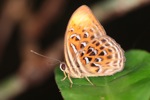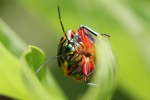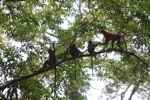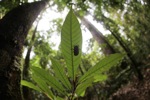
Clear water stream in Gunung Palung. All photos by Rhett A. Butler.
Gunung Palung National Park is one of the most important rainforest reserves in Indonesia. It is also spectacular.
Located in West Kalimantan, the western most province of Indonesia Borneo, Gunung Palung is today an ecological island due to large-scale destruction of the lowland forests that once surrounded it. Unfortunately illegal logging has now moved into the park. Much of this is driven by international demand for timber—hardwoods are commonly harvested by locals, trafficked by dealers in the nearby city of Ketapang, and then laundered through Malaysia as sustainably harvested Malaysian wood. But illegal logging in Gunung Palung is also the product of a new industry: construction of housing for swiftlets, which build nests used to make bird’s nest soup, a Chinese delicacy. Loggers are joined by commercial hunters who poach wildlife — including orangutans — from the park.

Cleared peat forest in the process of being drained outside Gunung Palung. All photos by Rhett A. Butler.
Once logged, forest areas are often converted to agriculture, especially oil palm and rubber plantations. Subsistence farming is also an important driver of forest conversion. (Deforestation inside and around Gunung Palung will be explored at greater length in a future post.)
These activities were quite apparent when I visited Gunung Palung in late February and early March. My hike into the park began with an hour walk through a landscape of twisted tree limbs and burned out trunks that once belonged to canopy giants. The din of chainsaws rang as I passed piles of freshly cut wood.
Lacking tree cover, this part of the hike was quite hot. Once we entered the forest however, the air cooled dramatically, but the chorus of chainsaws continued.

Borneo rainforest
The forest got taller and darker as we walked. The hike is essentially flat. The most difficult aspects are log crossings over rivers, a couple of wet stream crossings, and the stumbling hazard presented by roots and vines. By Borneo standards it is pretty tame (If you haven’t been to tropical Asia, be ready for heat and humidity. Leeches also might be a new experience for you, so you’ll probably want long pants tucked into your socks or boots). The hike, at a leisurely pace with a lunch break and lots of photo-taking, took just under six hours to the Cabang Panti Research Station. At other times of the year, when river levels are higher, it is possible to take a boat to Cabang Panti. I’m told it takes around 10 hours.

Red Leaf Monkey (Presbytis rubicunda)
Cabang Panti is situated on a clearwater stream and surrounded by a variety of forest types which support a stunning array of plant and animal species. The station, which was established by ecologist Mark Leighton in 1984, is also notable for the caliber of researchers that it has housed over the years. Orangutan researcher Cheryl Knott, plant specialist Cam Webb, lemur expert Patricia Wright, and ecologist Lisa Curran, are among the many distinguished scientists who have conducted research at Cabang Panti.
In my travels in Kalimantan, the forest of Gunung Palung around Cabang Panti ranks among the best. Within 24 hours of arriving I had already seen wild orangutans, red leaf monkeys, gibbons, bearded pigs, a variety of lizards and frogs, a cobra (a little too close for comfort), and an innumerable diversity of insects (but virtually no mosquitoes). A two hour walk from Cabang Panti takes you to Riam Berasap, a gorgeous waterfall on the same river that flows by the research station.

Red, white, and blue butterfly
But as magical as Cabang Panti was for me, the hike out was heart-breaking: the forest gets progressively more degraded and the drone of chainsaws grows louder with each step. A memorable moment came when we encountered a mother orangutan with her baby climbing in a low canopy tree. As we watched, our ears were assaulted by the ear-splitting whine of the rainforest primeval being torn down. Just a couple hundred meters away was the edge of the forest—that oppressively hot Armageddon that was just a short while ago verdant rainforest.

Chopped down rainforest tree
How to get there: The most direct route (not the way I went) is to fly from Jakarta to Pontianak (West Kalimantan) and then to Ketapang. A number of carriers do the first leg, but the second flight to Ketapang is limited to two regional carriers (Kalstar and Trigana). Getting tickets and confirmation can be a challenge (6 trips to the ticket office at the Banjarmasin airport just trying to pay for the Kalstar ticket) so you might want to find an Indonesian travel agent. There is also a boat option from Pontianak.
Once you reach Ketapang, you’ll need to find your way to Sukadana, which is two hours by private car or motorbike and longer by bus. There are several access points to Gunung Palung but I departed from a small village about 30 minutes by motorbike from Sukadana.
Arrangements: There are day tours of Gunung Palung offered by various operators. Because I did not partake in these, I can’t make any recommendations. Cabang Panti is generally closed to non-researchers, but there is a new program (I was a guinea pig) that aims to bring a handful of visitors (5-6 I was told) per month. The program is administered by the Park Office in Ketapang (not far from the airport). The office can set you up with guides and porters, if you need them (porters are from the local community and hiring them thus demonstrates the benefit of conserving the park).
Amenities: Cabang Panti has a generator that runs from dusk until bed time. The drinking water source is the river, which according to recent tests is very clear (I didn’t have any issues and found it sweet-tasting). Food is prepared by the station’s cook and consists of typical rural Indonesia fare (a lot of rice).

Forest dragon with blue eyes
Cost: Fares vary depending on availability, but my flights from Ketapang back to Jakarta totaled $120. Pricing for the Cabang Panti excursion hadn’t been firmly established when I arrived, but the park hopes to make it a low-volume, premium service to minimize the impact on the park and the ongoing research. Remember you are paying for access to a place that is increasingly rare in Borneo—lowland rainforest—at a beautiful site, rather than services or amenities. So this isn’t budget travel. Think of it as a once-in-a-lifetime experience to see wild orangutans in the rainforest of Borneo.
Page 1 | Page 2 | Page 3 | Page 4 | Page 5 | Page 6 | Page 7 | Page 8 | Page 9 | Page 10






























































